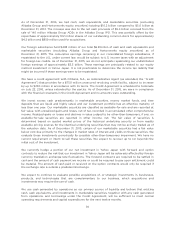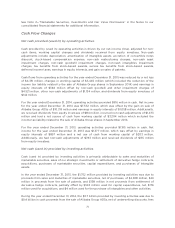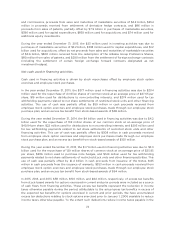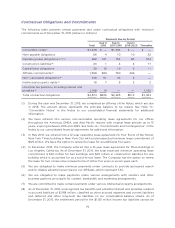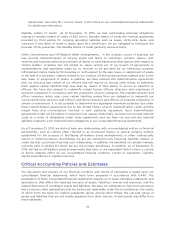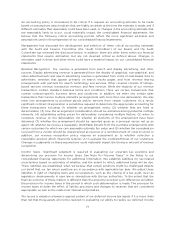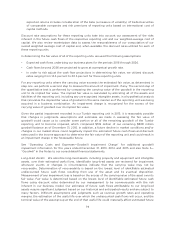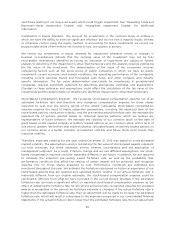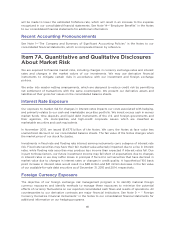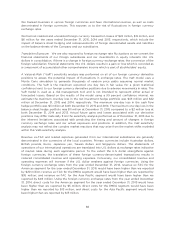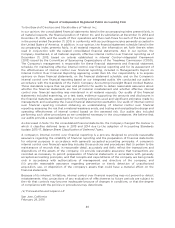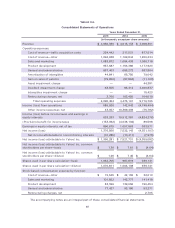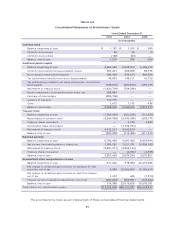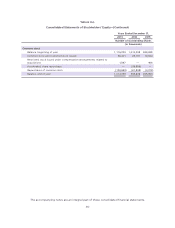Yahoo 2015 Annual Report Download - page 84
Download and view the complete annual report
Please find page 84 of the 2015 Yahoo annual report below. You can navigate through the pages in the report by either clicking on the pages listed below, or by using the keyword search tool below to find specific information within the annual report.cash flows relating to our long-lived assets which could trigger impairment. See “Operating Costs and
Expenses—Asset Impairment Charge” and “Intangibles Impairment Charge” for additional
information.
Investments in Equity Interests. We account for investments in the common stock of entities in
which we have the ability to exercise significant influence but do not own a majority equity interest
or otherwise control using the equity method. In accounting for these investments we record our
proportionate share of the entities’ net income or loss, one quarter in arrears.
We review our investments in equity interests for impairment whenever events or changes in
business circumstances indicate that the carrying value of the investment may not be fully
recoverable. Investments identified as having an indication of impairment are subject to further
analysis to determine if the impairment is other-than-temporary and this analysis requires estimating
the fair value of the investment. The determination of fair value of the investment involves
considering factors such as the stock prices of public companies in which we have an equity
investment, current economic and market conditions, the operating performance of the companies,
including current earnings trends and forecasted cash flows, and other company and industry
specific information. The fair value determination, particularly for investments in privately-held
companies, requires significant judgment to determine appropriate estimates and assumptions.
Changes in these estimates and assumptions could affect the calculation of the fair value of the
investments and the determination of whether any identified impairment is other-than-temporary.
Stock-Based Compensation Expense. We recognize stock-based compensation expense net of an
estimated forfeiture rate and therefore only recognize compensation expense for those shares
expected to vest over the service period of the award. Calculating stock-based compensation
expense requires the input of highly subjective assumptions, including the expected term of the
stock-based options, stock price volatility, and the pre-vesting award forfeiture rate. We estimate the
expected life of options granted based on historical exercise patterns, which we believe are
representative of future behavior. We estimate the volatility of our common stock on the date of
grant based on the implied volatility of publicly traded options on our common stock, with a term of
one year or greater. We believe that implied volatility calculated based on actively traded options on
our common stock is a better indicator of expected volatility and future stock price trends than
historical volatility.
Therefore, expected volatility for the year ended December 31, 2015 was based on a market-based
implied volatility. The assumptions used in calculating the fair value of stock-based awards represent
our best estimates, but these estimates involve inherent uncertainties and the application of
management judgment. As a result, if factors change and we use different assumptions, our stock-
based compensation expense could be materially different in the future. In addition, we are required
to estimate the expected pre-vesting award forfeiture rate, as well as the probability that
performance conditions that affect the vesting of certain awards will be achieved, and recognize
expense only for those shares expected to vest. Performance conditions are estimated and
monitored throughout the year. We estimate this forfeiture rate based on historical experience of our
stock-based awards that are granted and cancelled before vesting. If our actual forfeiture rate is
materially different from our original estimates, the stock-based compensation expense could be
significantly different from what we have recorded in the current period. Changes in the estimated
forfeiture rate can have a significant effect on reported stock-based compensation expense, as the
effect of adjusting the forfeiture rate for all current and previously recognized expense for unvested
awards is recognized in the period the forfeiture estimate is changed. If the actual forfeiture rate is
higher than the estimated forfeiture rate, then an adjustment will be made to increase the estimated
forfeiture rate, which will result in a decrease to the expense recognized in our consolidated financial
statements. If the actual forfeiture rate is lower than the estimated forfeiture rate, then an adjustment
80


